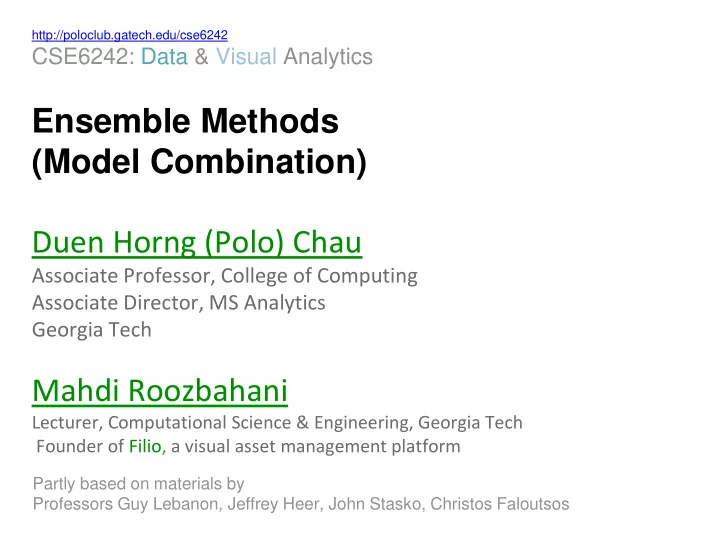

http://poloclub.gatech.edu/cse6242 CSE6242: Data & Visual Analytics Ensemble Methods (Model Combination) Duen Horng (Polo) Chau Associate Professor, College of Computing Associate Director, MS Analytics Georgia Tech Mahdi Roozbahani Lecturer, Computational Science & Engineering, Georgia Tech Founder of Filio, a visual asset management platform Partly based on materials by Professors Guy Lebanon, Jeffrey Heer, John Stasko, Christos Faloutsos
Numerous Possible Classifiers! Cross vali Classifier Training Testing time Accuracy time dation kNN classifier None Can be slow Slow ?? Decision trees Slow Very slow Very fast ?? Naïve Bayes Fast None Fast ?? classifier … … … … … 3
Which Classifier/Model to Choose? Possible strategies: • Go from simplest model to more complex model until you obtain desired accuracy • Discover a new model if the existing ones do not work for you • Combine all (simple) models 4
Common Strategy: Bagging ( B ootstrap Agg regat ing ) Originally designed for combining multiple models, to improve classification “stability” [Leo Breiman, 94] Uses random training datasets (sampled from one dataset) http://statistics.about.com/od/Applications/a/What-Is-Bootstrapping.htm 5
Common Strategy: Bagging ( B ootstrap Agg regat ing ) Consider the data set S = {(x i , y i )} i=1,..,n • Pick a sample S * with replacement of size n (S* called a “bootstrap sample”) • Train on S * to get a classifier f * • Repeat above steps B times to get f 1 , f 2 ,...,f B • Final classifier f(x) = majority {f b (x)} j=1,...,B http://statistics.about.com/od/Applications/a/What-Is-Bootstrapping.htm 6
Bagging decision trees Consider the data set S • Pick a sample S * with replacement of size n • Grow a decision tree T b • Repeat B times to get T 1 ,...,T B • The final classifier will be 8
Random Forests Almost identical to bagging decision trees, except we introduce some randomness: • Randomly pick m of the d available attributes, at every split when growing the tree (i.e., d - m attributes ignored) Bagged random decision trees = Random forests 9
Explicit CV not necessary • Unbiased test error can be estimated using out-of-bag data points (OOB error estimate) • You can still do CV explicitly, but that's not necessary, since research shows that OOB estimate is as accurate Section 15.3.1 of http://statweb.stanford.edu/~tibs/ElemStatLearn/printings/ESLII_print10.pdf https://www.stat.berkeley.edu/~breiman/RandomForests/cc_home.htm#ooberr http://stackoverflow.com/questions/18541923/what-is-out-of-bag-error-in-random-forests 10
Important points about random forests Algorithm (hyper) parameters • Usual values for m: • Usual value for B : keep adding trees until training error stabilizes 11
Important points about random forests Algorithm (hyper) parameters • Size/#nodes of each tree • as in when building a decision tree • May randomly pick an attribute, and may even randomly pick the split point! • Significantly simplifies implementation and increases training speed • PERT - Perfect Random Tree Ensembles http://www.interfacesymposia.org/I01/I2001Proceedings/ACutler/ACutler.pdf • Extremely randomized trees http://orbi.ulg.be/bitstream/2268/9357/1/geurts-mlj-advance.pdf 12
Advantages • Efficient and simple training • Allows you to work with simple classifiers • Random-forests generally useful and accurate in practice (one of the best classifiers) • The other is gradient-boosted tree http://fastml.com/what-is-better-gradient-boosted-trees-or-random-forest/ • Embarrassingly parallelizable 13
Final words Reading material • Bagging: ESL Chapter 8.7 • Random forests: ESL Chapter 15 http://www- stat.stanford.edu/~tibs/ElemStatLearn/printing s/ESLII_print10.pdf 14
Recommend
More recommend